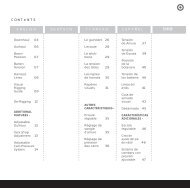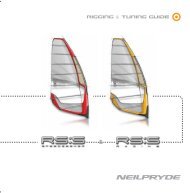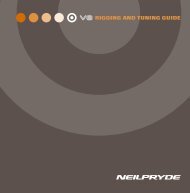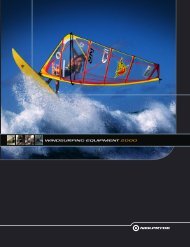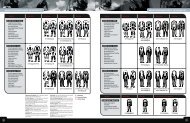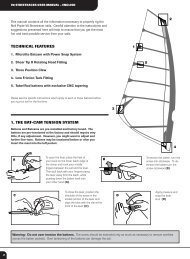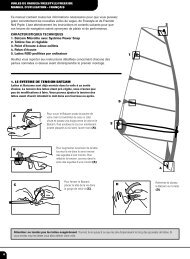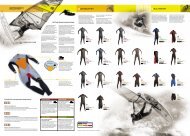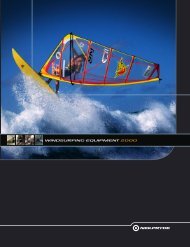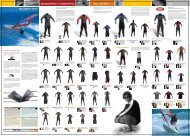Worksheet Sail Launch/02 - Neil Pryde
Worksheet Sail Launch/02 - Neil Pryde
Worksheet Sail Launch/02 - Neil Pryde
You also want an ePaper? Increase the reach of your titles
YUMPU automatically turns print PDFs into web optimized ePapers that Google loves.
✬✣✧✪✂✮✰✷✢✣✂✱✚✧✪✂✰✚✬✥✣✂☞✡✡✌<br />
The new 2003 sail collection from <strong>Neil</strong> <strong>Pryde</strong> is an innovative blend of pure product<br />
design and Elegant Engineering. What follows is the story of the who’s, how’s,<br />
what’s and why’s that have resulted in this distinctive new collection and<br />
underscores why <strong>Neil</strong> <strong>Pryde</strong> is still the No. 1 sail maker in the world of windsurfing<br />
The Background Story<br />
<strong>Neil</strong> <strong>Pryde</strong>’s 2003 sail line up marks<br />
something of a departure from the splashy<br />
graphic styles that have become a hallmark of<br />
contemporary windsurf sail design. Clean<br />
lines and a distinctly elegant, understated<br />
style reflect this shift in thinking - pure<br />
performance and elegant engineering are the<br />
central themes at the heart of this new<br />
collection and it’s these themes that have<br />
guided the <strong>Neil</strong> <strong>Pryde</strong> design team in their<br />
approach to this project.<br />
Simon Narramore, the <strong>Neil</strong> <strong>Pryde</strong> Brand<br />
Manager, Robert Stroj, <strong>Neil</strong> <strong>Pryde</strong>’s Chief <strong>Sail</strong><br />
Designer and Thomas Meyerhoffer, an<br />
industrial design consultant from California,<br />
spearheaded the sail development<br />
programme, and over the last 12 months have<br />
collaborated to create one of the most<br />
technically advanced sail collections ever<br />
produced by the brand.<br />
The design team set out to develop a recognisable,<br />
engineered continuity throughout the<br />
<strong>Neil</strong> <strong>Pryde</strong> sail range, the most visible element<br />
of which has been dubbed “The Frame” –<br />
a distinctive outer edge around the sail.<br />
The frame gives a visual clue to the actual<br />
purpose of the individual sails. Styled like a<br />
set of blades – you can see at a glance that<br />
there’s a more robust, chopping edge to the<br />
frame on the wave and crossover sails,<br />
whereas the faster flat-water sails appear to<br />
have a leaner, slicing edge to their frames.<br />
an approach that’s given the sails a distinctive<br />
family resemblance, through a shared, easily<br />
recognisable silhouette.<br />
“If you look at the classic cars like a VW Beetle<br />
or the 911 Porsche, they’re instantly recognisable,<br />
even at quite a distance” explains<br />
<strong>Neil</strong> <strong>Pryde</strong> Brand Manager Simon Narramore,<br />
“there’s a strong visual element to the work<br />
we’ve been doing with this project too.<br />
“We wanted to develop a line<br />
of sails with a distinctive <strong>Neil</strong> <strong>Pryde</strong><br />
silhouette that would be instantly<br />
recognisable out on the water.<br />
But we wanted to do this without<br />
slapping huge coloured graphics on<br />
the sail right at the end.”<br />
“We wanted to develop a line of sails with a<br />
distinctive <strong>Neil</strong> <strong>Pryde</strong> silhouette that would be<br />
instantly recognisable out on the water. But<br />
we wanted to do this without slapping huge<br />
coloured graphics on the sail right at the end<br />
of the design phase.<br />
“Again, if you look at the great car marques<br />
over the years, individual models have<br />
developed over the years like the 911<br />
Porsche or the Beetle and the Golf at VW, the<br />
silhouettes my alter a little each year but the<br />
model remains as essentially the same<br />
recognisable platform, for many years,<br />
delivering a particular level of performance to<br />
a particular type of customer.<br />
“With sails it seems the market is saturated<br />
with models from many different companies<br />
and it’s almost impossible for people to know<br />
what they’re getting. Everything seems to get<br />
changed every season, from product names<br />
to colours and styling so how can we expect<br />
our customers to keep up with it all?<br />
“We’ve got some established sail models in<br />
the <strong>Neil</strong> <strong>Pryde</strong> range and we’ve been working<br />
to define some uniquely recognisable shapes<br />
and styles for these individual product<br />
platforms. With that done we can then focus<br />
on refining each of them, just like the car<br />
companies do.<br />
“A V8 customer or a Core customer<br />
expects certain distinctive performance<br />
characteristics from their sail. I’d rather<br />
Rather than applying aggressive graphic<br />
elements over the surface of the sails, these<br />
simple styling cues have been skilfully<br />
engineered into the body and structure of the<br />
sails themselves. Part form, part function it’s
see our designers in Maui focusing on<br />
providing better performance each<br />
season than worrying about how to make<br />
the sails look different to last year. If they<br />
look right in the first place, why keep<br />
messing with them?<br />
“Within each of our product model<br />
platforms we now have a clearly prescribed<br />
performance spectrum. It’s now up to<br />
Robert Stroj and his test team to constantly<br />
refine this performance year-on-year. The<br />
names and the basic silhouette of our sails<br />
should remain recognisably the same so<br />
that our customers can easily identify the<br />
models they prefer and so that the sails in<br />
their quiver don’t end up looking completely<br />
different from one year to the next.<br />
“These new sails that Robert and Thomas have<br />
designed are particularly subtle and elegant<br />
- this is really what I see as the <strong>Neil</strong> <strong>Pryde</strong> trademark.<br />
The purely aesthetic parts of the product<br />
design have now been ‘elegantly engineered’<br />
into the sails themselves rather than layered<br />
on at the end with coloured materials.<br />
“The purely aesthetic parts of the<br />
product design have now been<br />
‘elegantly engineered’ into the sails”<br />
“The great thing about working with Robert is<br />
that he’s such an excellent engineer. We’d worked<br />
with Thomas Meyerhoffer and he’s brought us<br />
these amazing concept drawings. We all loved<br />
the drawings, but the problem remained - how<br />
would they actually work on the water?<br />
“Over the course of the past six or seven<br />
months, Robert and Thomas have worked<br />
together and figured out how to form them into<br />
working sails that look fantastic and perform at<br />
the very highest levels out on the water.<br />
“You’ve got to remember, it’s a tough job<br />
making sails for the likes of Dunkerbeck,<br />
Polakow, Albeau and Stone - they’re a<br />
particularly demanding audience. The guys in<br />
the design team have not only built a line of<br />
sails that our team riders all love to use, but<br />
they’ve done it with a lot of style and with the<br />
kind of finesse that you don’t often see in<br />
windsurfing these days.<br />
The Product Design Team<br />
Robert Stroj<br />
Chief <strong>Sail</strong> Designer<br />
Thomas Meyerhoffer<br />
Industrial Design Consultant<br />
Simon Narramore<br />
<strong>Neil</strong> <strong>Pryde</strong> Brand Manager<br />
As Chief <strong>Sail</strong> Designer at <strong>Neil</strong> <strong>Pryde</strong>, Robert’s<br />
efforts to continually push the limits of<br />
performance and engineering are tireless.<br />
Since making his debut at with the hugely<br />
successful RS-1 Racing <strong>Sail</strong>, Robert has gone<br />
from strength to strength in the two years<br />
since he has been with <strong>Neil</strong> <strong>Pryde</strong>.<br />
Robert’s development work on the wave and<br />
freestyle sails have also earned him great respect<br />
from some of the world’s top sailors, with Antoine<br />
Albeau winning last year’s freestyle world title<br />
on Robert’s innovative Expression sail.<br />
Thomas is no stranger to great design having<br />
worked for some of the world’s leading<br />
product companies: Apple, Nike and Ericsson<br />
to name but a few.<br />
Based in California close to the Ocean, and<br />
a keen surfer and windsurfer himself, Thomas<br />
brings with him a subtle blend of Scandinavian<br />
simplicity and California-cool. His collaboration<br />
with the <strong>Neil</strong> <strong>Pryde</strong> design team has helped<br />
define the unique look of the 2003 collection –<br />
a look that could easily redefine the face of<br />
modern windsurfing sail engineering.<br />
The driving force behind the 2003 sail design<br />
programme, Simon is an award-winning<br />
marketer who is dedicated to maintaining<br />
<strong>Neil</strong> <strong>Pryde</strong>’s position as the No.1 windsurfing<br />
brand on the water.<br />
His decision to combine Robert’s technical<br />
expertise with Thomas’s design abilities was<br />
instrumental in creating what is certainly<br />
one of the most elegant, technically<br />
accomplished sail collections ever produced<br />
by <strong>Neil</strong> <strong>Pryde</strong>.
Design & Development<br />
Elegance That Works On The Water<br />
The central design theme of the 2003<br />
collection has been dubbed “The Frame” - a<br />
distinctive outer edge around the sail that<br />
gives a visual clue to the actual performance<br />
range of the individual sails. We asked Thomas<br />
Meyerhoffer to elaborate a little on the<br />
background thinking behind these distinctively<br />
elegant designs:<br />
“ We basically began by looking at what<br />
everybody’s doing in the market and as<br />
anyone can see, many of the sails have begun<br />
to look the same. You have your mast sleeve<br />
and batten pockets, you put some film in<br />
between them and then someone simply<br />
smacks a big graphic right across the middle<br />
of it all. We really wanted to step out of that<br />
and create something a little different.<br />
with each sail formed a little differently. The<br />
styling of each model varies depending on<br />
what the actual sail does on the water. For<br />
example, the wave sails are very aggressively<br />
styled and the flatwater sails tend to be<br />
simpler and more streamlined.<br />
“There’s a lot of functionality in the designs<br />
too - the wavesails and the freestyle sails<br />
remain very open in the middle, the window<br />
area is much larger than normal so you can<br />
see very clearly what you’re doing and where<br />
you are on the wave. You can also see we’ve<br />
used more x-ply to reinforce those sails so<br />
they’re very well built - but they stay light and<br />
easy to handle as well.”<br />
With sailmaking however, styling counts for<br />
nothing if the sails don’t perform on the water,<br />
and at <strong>Neil</strong> <strong>Pryde</strong> the performance standards<br />
have been set very high indeed. A top priority<br />
in the development process is always testing<br />
the sails with the team riders to ensure that<br />
their performance was up to par.<br />
“We worked very closely with Antoine Albeau<br />
on the Expression,” explains <strong>Neil</strong> <strong>Pryde</strong> Head<br />
of Design, Robert Stroj. “I’m sure that all the<br />
work we’ve done with Antoine on the<br />
Expression has helped him become the<br />
current Freestyle World Champion – there’s<br />
no question, he’s contributed a huge amount<br />
to developing this year’s sail.<br />
“ We basically began by looking at<br />
what everybody’s doing in the market<br />
and as anyone can see, many of the<br />
sails have begun to look the same...<br />
We really wanted to step out of that<br />
and create something a little different.”<br />
“I guess the real question we started with<br />
was how to break away from this basic<br />
formula, how to make the sail different from<br />
a kit of parts, a coloured mast sleeve, some<br />
coloured battens and some big graphics that<br />
you simply juggle around to look different<br />
every season.<br />
“My initial approach was to make the battens<br />
visually blend into to sails, or best of all to<br />
make them “disappear” altogether. As we<br />
experimented with this it began to lead us to<br />
a very different look and these explorations<br />
finally brought us to our “Frame” theme.<br />
“The frame wraps around the sail and as<br />
you’ll see it kind of opens up in the back,
“You can see that Antoine is a really big guy, so<br />
he needs a sail that will give him a lot of speed<br />
and power. You have to remember that he’s<br />
competing with a lot of smaller, lighter guys who<br />
have a natural advantage in freestyle, so power,<br />
speed and manoeuvrability were all important<br />
factors here. We’re really seeing the Expression<br />
becoming the Freestyle sail for bigger guys.”<br />
Nowhere is rider input more important than<br />
through the Signature Series wave sails. The<br />
Signature Series sails are developed around<br />
the sailing style and character of some of the<br />
world’s best sailors:<br />
The Search is used by the Power Pair - Bjorn<br />
Dunkerbeck and Antoine Albeau. The Zone<br />
is the weapon of choice of Jason Polakow<br />
and the Core is the favoured sail of Josh<br />
Stone and several of the young up-andcoming<br />
sailors on the <strong>Neil</strong> <strong>Pryde</strong> team, such<br />
as Ricardo Campello and Diony Guadagnino.<br />
All of these riders have been involved in the<br />
development programme of the 2003 sails with<br />
Robert Stroj devoting much of his time to fine<br />
tuning the performance of individual models to<br />
meet their exact demands, as he now explains:<br />
“If you look at the Search, you can see that<br />
it’s a no-compromise, powerful wave sail.<br />
Compared to last year’s model it’s much<br />
stronger built, with the whole top area of the<br />
sail now in X-ply. You can clearly see that<br />
this sail is all about power; it’s what the bigger<br />
guys like Bjorn and Antoine demand.”.<br />
“This year’s Zone, is the most radical of all<br />
the wave sails. Right away you’ll see how it<br />
reflects Jason’s sailing style. The lines of this<br />
sail are extremely sharp, dynamic and radical.<br />
“Jason always asks for a sail that’s very fast<br />
down the line, which flattens nicely, depowers<br />
when he’s in the cutbacks and in the<br />
jumps has a stable profile. It’s why he<br />
demands five battens – basically he wants a<br />
sail that has a wide wind range, that’s light<br />
in the hands and stable.”<br />
A big development has been the evolution<br />
of the Core, Josh’s Signature sail. Robert<br />
continues:<br />
“This year’s Core is very different in comparison<br />
to last year’s model because the bigger sizes<br />
have been specially designed for freestyle.<br />
“The younger riders have been asking me to<br />
give them a 4 batten freestyle sail, something<br />
soft, light and forgiving. I realised that there<br />
was actually no point in developing a new<br />
freestyle sail, we already have the Core and<br />
this is the sail that the young guys love to use.<br />
They’re already using the Core all the way up<br />
to 5.3, the only problem was that they were<br />
missing the bigger sizes. So that’s what they<br />
got this year!”<br />
The final area of the development process<br />
was sourcing new materials. With the dramatic<br />
new frame design, a whole new colour system<br />
has been developed to maximise the visual<br />
impact of the sails. Both Robert and Thomas<br />
have put a great deal of energy into<br />
researching new semi-transparent x-ply<br />
materials that give the 2003 sails their<br />
distinctive look.
The Result<br />
He takes feedback and input from the team<br />
riders very positively, so we’re able to get a<br />
lot of work done quickly and get the best<br />
possible product made.<br />
The results of the 2003 sail design<br />
programme have been declared a success<br />
by the both the Design Team and the Pro<br />
Team riders.<br />
“There’s no question, we really set ourselves<br />
a difficult task this season” reflects Brand<br />
Manager Simon Narramore. “We set out to<br />
create this distinctive ‘elegantly engineered’<br />
silhouette for the products which has been<br />
quite a challenge in itself. Meanwhile we<br />
were also under all the usual pressure from<br />
our Pro Team riders to give them sails that<br />
perform at the highest level out on the water.<br />
Juggling the two issues simultaneously has<br />
been a tricky business to manage.”<br />
Clearly the Team riders agree that progress<br />
has been made in all the right areas:<br />
X9 mast is so light and you really feel the<br />
difference in weight when you’re on the<br />
water, it’s an incredible combination”<br />
“For me it’s important to have an allround<br />
sail, because I like to sail in all<br />
kinds of conditions from hardcore<br />
down-the-line wavesailing to trickster,<br />
new school freestyle, and the Core<br />
let's me do it all.”<br />
Josh Stone<br />
Team mate and test partner on the Zone,<br />
Greg Allaway is also quick to show his<br />
support for the 2003 Zone:<br />
“I’m just super stoked, the new Core is killer.<br />
We’ve moved the draft forward, and stabilized<br />
the power, which makes it much better for<br />
down-the-line wave sailing. You can really<br />
lay it down hard in the bottom turns and it<br />
will de-power, for a very smooth, clean turn.<br />
Of course we’ve maintained it's excellent<br />
manoeuvrability, the new Core feels really<br />
light, which makes it great for freestyling.<br />
For me it’s important to have an all-round<br />
sail, because I like to sail in all kinds of<br />
conditions from hardcore down-the-line<br />
wavesailing to trickster, new school freestyle,<br />
and the Core let's me do it all. So you really<br />
couldn’t ask for anything more.<br />
Head of Design Robert Stroj believes a new<br />
standard has been set with the 2003 sail<br />
collection:<br />
“What makes me really excited about the<br />
new line is that together we’ve managed to<br />
develop a completely new approach to sail<br />
design, where the product is actually built<br />
and styled from the beginning instead of<br />
just adding superficial graphic styling to the<br />
finished sail just to make it look good.”<br />
“The new Zones are technically very well<br />
built”, enthuses Jason Polakow, “You see it<br />
immediately when you look at them. In<br />
performance terms, the new Zone is softer,<br />
especially the 4.7 and below, which means<br />
it’s great for pumping out of the lulls.<br />
“I’m also finding that I can use smaller sails<br />
in competition, which is always a plus.<br />
There’s also a little more twist-off at the top<br />
of the new sails which makes them more<br />
forgiving when you’re overpowered.<br />
“I’ve been using the new X9 mast in the<br />
new sails and they feel great together. The<br />
“These new Zone’s have an easy, wellbalanced<br />
feel so whether you’re in a bottom<br />
turn where you need a lot of power or you’re<br />
coming off the top of a wave, the Zone<br />
handles really well. This year’s sails are<br />
definitely stronger than before and the new<br />
design, with its huge window area offers<br />
much more visibility making it the perfect<br />
sail for me.”<br />
Josh Stone also has a lot of good things to<br />
say about his new Core sails. “I'm really<br />
excited about the changes we made this<br />
year. Robert is an incredible designer and<br />
it’s been a real pleasure working with him.<br />
“Obviously for a high performance product<br />
like a windsurfing sail, the styling is only a<br />
beginning. The real test is out on the water<br />
in the hands of the riders and our customers<br />
who buy the sails.<br />
“We’ve managed to reduce the weight of<br />
the sails across the range, and even though<br />
they look and feel lighter, they’re actually<br />
stronger than ever. I’m happy to say that<br />
sails look fantastic and the team riders love<br />
using them.
NEILPRYDE SAIL RANGE 2003 WAVE<br />
The Signature Wavesail of Bjorn Dunkerbeck.<br />
The most powerful of the three wave sails, the Search has been formulated around the virtues of the 12 X World<br />
Champion: Power, Stability, and Consistency. The Search is designed around three principles: Excellent low-end<br />
power for early planing, wide wind range for use in varying conditions, and stability for optimal control. The low<br />
end power is achieved through more aggressive shaping in the bottom section of the sail. The Search has a wide<br />
wind range and is designed to be a lively sail with very quick response. This means a sail body that will work in<br />
unison and react instantly to the gusts and lulls faced in less than ideal conditions. The stability comes from a<br />
combination of stable draft placement and a relatively flat top section that allows the leech to open up softly and<br />
efficiently without disturbing the flow of air across the sail.<br />
Five battens for stability » Aggressive shaping for more power » High aspect ratio with<br />
longer mast for high response » Light construction built to endure the waves » Top section<br />
shaping for increased power in onshore conditions<br />
Five batten configuration<br />
Luffglide Luffpocket Material<br />
CNC Tapered Rod Battens<br />
Rounded Head Configuration<br />
3.9 4.2 4.5 4.7 5.0 5.4 5.8 6.2
NEILPRYDE SAIL RANGE 2003 WAVE<br />
The Signature Wavesail of Jason Polakow.<br />
Specifically designed to match the radical wave sailing style of Jason Polakow who demands a sail that reacts to his<br />
every whim. The Zone has less shaping than the Search and a lower aspect ratio, which lowers the center of effort.<br />
It also has a flatter top section, which combined with the lower center of effort, translates into a well balanced sail<br />
that has ample power down low and lots of release in the head. This aspect, combined with a well rotated body that<br />
quickly flattens out and depowers on demand, allows the sail to completely neutralize and disappear when doing<br />
bottom turns, and then quickly power back up to speed to allow you to do as you please with the wave. Light but bomb<br />
proof construction, designed to take a beating in big waves, like Jason himself.<br />
Five battens for stability » Moderate shaping for power & lightness » Moderate aspect ratio<br />
for high response & low center of effort » Well rotated body that flattens out and depowers<br />
instantly » Light but strong construction with limited use of monofilm, maximum use of X-Ply<br />
Five Batten Configuration<br />
Luffglide Luffpocket Material<br />
CNC Tapered Rod Battens<br />
Rounded Head Configuration<br />
3.3 3.7 4.1 4.4 4.7 5.0 5.3 5.7
NEILPRYDE SAIL RANGE 2003 WAVE<br />
The Signature sail of Josh Stone.<br />
The lightest of the three Signature sails specifically designed for the light to medium weight, wave and freestyle<br />
sailors. With only four battens and an even lower aspect ratio than the Zone, it is the most forgiving of all the<br />
wavesails. The flat shaping and compact outline give the Core a soft feel with the power coming from down low<br />
where it is most controllable. This allows you to power and depower the sail at will permitting you to set up for<br />
radical maneuvers. The smaller sizes are dedicated for radical waveriding and the lighter wave sailors like Josh,<br />
while the bigger sizes are dedicated for the radical freestyle sailors just like Josh!<br />
Four battens/ Lightweight » Flatter shaping for excellent depowering » Compact outline<br />
with low aspect ratio for a lower center of gravity » Specific window outline for ultimate<br />
visibility and maximum sail reinforcement » Light but strong construction with limited use<br />
of monofilm, maximum use of X-Ply<br />
Four Batten Configuration<br />
Luffglide Luffpocket Material<br />
CNC Tapered Rod Battens<br />
Rounded Head Configuration<br />
2.9 3.3 3.7 4.1 4.4<br />
4.7 5.1 5.4 5.7 6.2
NEILPRYDE SAIL RANGE 2003 CROSSOVER<br />
The sail of choice of Freestyle World Champion Antoine Albeau.<br />
The Expression has been designed to provide very early planing power with the balance and control needed<br />
for sophisticated maneuvers. The result has been a powerful, responsive, and balanced sail that is a step above<br />
the Search in low-end power but with a more forgiving body that allows the sail to flatten out and depower at<br />
will. This allows the sail to stay neutral when sheeted out which is crucial for pulling off maneuvers. These<br />
characteristics have been accomplished through aggressive shaping in the lower part of the sail combined with<br />
a well-rotated body. A lightweight construction with reinforced foot area make the Expression an ideal crossover<br />
sail for full-on freestyle as well as for moderate conditions wave sailing.<br />
Five battens for stability » Shaped for added lift, essential in freestyle » Similar high<br />
aspect ratio to the Search for high sail response » Well rotated body that flattens out and<br />
depowers instantly » Lightweight construction with reinforced critical foot area<br />
Five Batten Configuration<br />
Luffglide Luffpocket Material<br />
CNC Tapered Rod Battens<br />
Rounded Head Configuration<br />
4.2 4.7 5.2 5.7 6.2 6.7 7.2
NEILPRYDE SAIL RANGE 2003 CROSSOVER<br />
The RAF Jet is a very versatile crossover sail specifically oriented for flat-water cruising or maneuvers.<br />
Designed to provide the top end speed and control for flat water blasting with the low end and stability needed<br />
for freestyle. This has been accomplished through the use of draft forward shaping for speed and control, a tube<br />
supported profile for draft stability, and a moderate foot outline to provide speed and maneuverability. With<br />
the use of progressive monofilm thickness, the RAF Jet also provides the lightness desired in the top of the sail<br />
for flat water cruising, and the heavier, stronger monofilm in the boom and foot area for a long lasting freestyle sail.<br />
Five battens configuration » Tube supported profile above the boom for draft stability » Draft<br />
forward shaping for speed and control » Moderate foot outline getting the most out of speed<br />
and maneuverability » Progressive use of monofilm thickness<br />
Five Batten Configuration<br />
Luffglide Luffpocket Material<br />
<strong>Neil</strong> <strong>Pryde</strong> Component Batten<br />
System<br />
Rounded Head Configuration<br />
4.9 5.4 5.9 6.4 6.9 7.4



